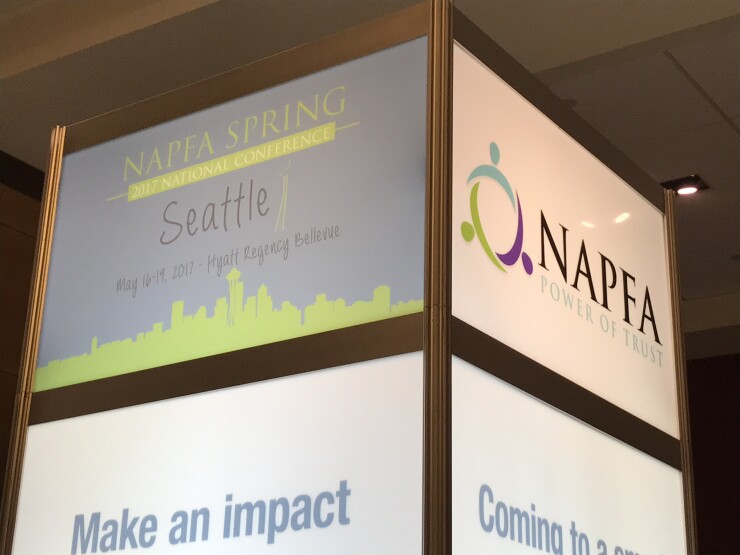In a bid to increase membership and boost brand awareness, the National Association of Personal Financial Advisors is teaming up with the CFP Board to offer free one-year memberships to newly minted fee-only CFPs.
The joint undertaking is intended to mutually support both nonprofits. NAPFA, which requires its members to operate fee-only practices, currently has 3,200 members, and annual dues for advisors usually cost $665 plus a processing fee. NAPFA CEO Geoffrey Brown anticipates the free membership program will add another 50 to 75 advisors to the new crop of 300 to 400 members who join the organization annually.
"I think it's a really good thing," says NAPFA member and CFP Sandra Field from Asset Planning in Cypress, California. "I'm still surprised when I run into people at conferences who don't know about NAPFA. When I'm talking fee-only, I assume they are a NAPFA members [and] they say, 'I've kind of heard of that. Is it worth it?'"

It's a conundrum NAPFA is well aware of. "I still feel like NAPFA is one of the best kept secrets in the planning world and we want to change that," Brown says.
While offering new and qualifying advisors a NAPFA membership is a perk the CFP Board can now offer, the collaboration will give NAPFA an introduction to new fee-only CFPs. Roughly 7,000 CFPs describe their firms as fee-only in their profiles on the board's letsmakeaplan.org website, according to the CFP Board.
Fee-only is a term taken by many in the industry as shorthand for an advisor's fiduciary commitment to his or her clients. Though nobody knows the true number, relatively few advisors nationwide run strictly fee-only practices. The 7,000 advisors on the board's website make up less than 10% of the more than 80,000 CFPs nationwide.
Founded in 1983, NAPFA solidified its bond with the CFP Board in 2012 when it began requiring all new members to hold CFP certifications. The move came with some controversy as NAPFA — once the standard-bearer of commission-free financial advice — linked arms with the wealthier, more powerful organization.
-
John helped found the coalition between the board, NAPFA and the FPA.
August 3 -
Planner Greg Phelps, one of the project volunteers, survived the shooting by sprinting across the concert grounds while bullets slugged into the ground.
April 6 -
What do they bring to the table? Lobbying clout, alternative fee structures and technical expertise are just part of the equation.
January 31
"The relationship between [the] CFP Board and NAPFA has been historically interesting," says Joseph Goetz, associate professor of financial planning and clinical supervisor of pro bono financial services at the University of Georgia, "because NAPFA has embraced this higher level of a fiduciary standard, where most CFPs didn't qualify [for NAPFA membership] because most certificants accept commissions of some sort."
In response, the CFP Board's spokesman Dan Drummond says, "There are conflicts of interest associated with every compensation structure. What is important is for financial planners to place their clients’ interests first, fully disclose material conflicts of interest, obtain informed consent and properly manage the conflict."
He adds that
In the meantime, NAPFA’s collaboration with the board could help further increase awareness of the RIA business model that most fee-only advisors employ, Goetz says.
"Exposure to NAPFA could be good to make [new CFPs] aware of more business models ... that may be more conducive to working in the best interests of a consumer," Goetz says.





